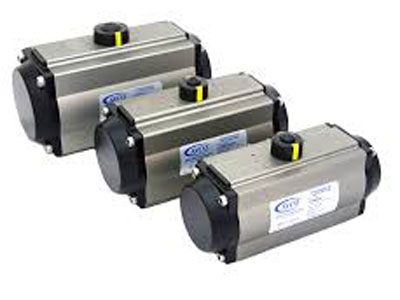What Are The Main Types Of Pneumatic Cylinders?
Key Takeaway
The main types of pneumatic cylinders are:
Single-acting cylinders: These have one port for air to enter, moving the piston in one direction. They use a spring or external force to return the piston to its original position.
Double-acting cylinders: These cylinders have two ports, allowing air to enter and exit in both directions. This enables the piston to extend and retract efficiently, making them more precise and commonly used in industrial applications.
Rodless cylinders: These cylinders do not have a piston rod. Instead, they move the load alongside the piston. They are more compact and provide the same force in both directions. Rodless cylinders are ideal for material handling, loading, and lifting applications.
Single-Acting Pneumatic Cylinders
Single-acting pneumatic cylinders are among the simplest types of pneumatic actuators. These cylinders use compressed air to generate motion in one direction, typically for extension. A built-in spring or an external force is then used to return the piston to its original position. This design makes them ideal for applications requiring unidirectional force, such as clamping, lifting, or pushing light loads.
One key advantage of single-acting cylinders is their minimal air consumption since air is only needed for one phase of the motion. This makes them energy-efficient and cost-effective for simple tasks. However, their force output is limited compared to double-acting cylinders because part of the energy is used to compress the return spring.
Due to their simplicity and reliability, single-acting pneumatic cylinders are widely used in applications such as pressing buttons, ejecting components, or operating simple mechanisms where bidirectional motion is not required.

Double-Acting Pneumatic Cylinders
Double-acting pneumatic cylinders are the most commonly used type in industrial applications due to their versatility and efficiency. Unlike single-acting cylinders, these devices use compressed air to move the piston in both directions, enabling extension and retraction. This bidirectional motion makes them suitable for a wide range of tasks requiring precision and control.
The force generated by double-acting cylinders is consistent in both directions, as there is no spring to reduce the effective force. This design is particularly advantageous in applications requiring higher loads or longer stroke lengths. For example, these cylinders are commonly used in assembly lines, material handling systems, and robotic arms where repetitive, controlled motion is essential.
Double-acting cylinders also allow for better speed and force regulation through control valves, giving engineers more flexibility in fine-tuning performance. Their ability to handle complex operations ensures they remain a cornerstone of modern automation systems.
Rodless Pneumatic Cylinders
Rodless pneumatic cylinders are designed to deliver linear motion without the need for a traditional piston rod. Instead, they utilize a moving carriage attached to the piston inside the cylinder body. This unique design makes them ideal for applications where space constraints are a concern, as they eliminate the need for additional room to accommodate a protruding rod.
Rodless cylinders can be mechanically or magnetically coupled. In mechanically coupled designs, a slot runs along the length of the cylinder, allowing the piston to connect directly to the carriage. Magnetically coupled versions use magnetic force to transfer motion through the cylinder wall, ensuring a completely sealed system.
These cylinders are highly versatile and are often found in applications like material transportation, positioning systems, and automated assembly lines. Their compact size, long stroke lengths, and smooth operation make them indispensable for industries aiming to maximize efficiency in limited spaces.
Telescopic Pneumatic Cylinders
Telescopic pneumatic cylinders are specialized actuators designed to achieve extremely long strokes while maintaining a compact initial size. These cylinders consist of multiple nested stages, which extend sequentially as compressed air is applied. This design allows them to deliver significant extension without requiring a large amount of space.
One of the main advantages of telescopic cylinders is their ability to operate in environments with tight spatial constraints. For example, they are commonly used in applications like lifting platforms, dump trucks, and other machinery where extended reach is necessary but space is limited.
Despite their complexity, telescopic pneumatic cylinders are reliable and efficient, providing consistent performance under demanding conditions. However, their design requires careful maintenance to ensure smooth operation of the multiple stages. With their unique capabilities, telescopic cylinders offer solutions for tasks that would otherwise be challenging with traditional actuators.
Compact Pneumatic Cylinders
Compact pneumatic cylinders are designed for applications where space is at a premium. These cylinders have a shorter length and are built to fit into tight spaces without compromising performance. Despite their small size, compact cylinders can generate significant force, making them suitable for a variety of industrial applications.
The design of compact cylinders focuses on efficiency and simplicity. They are often used in packaging machines, assembly lines, and robotic systems where the available space is limited but precise motion is required. Their lightweight and durable construction make them easy to install and maintain.
Additionally, compact pneumatic cylinders can be customized with various mounting options and stroke lengths, providing flexibility for specific tasks. Their ability to deliver high performance in a small package ensures they remain a popular choice in industries prioritizing space efficiency.
Conclusion
Pneumatic cylinders are essential components in industrial automation, with various types tailored to specific applications. Single-acting cylinders are simple and cost-effective for unidirectional tasks, while double-acting cylinders provide versatility and precision for complex operations. Rodless cylinders excel in space-constrained environments, and telescopic cylinders deliver long strokes in compact forms. Compact pneumatic cylinders, on the other hand, ensure high performance in tight spaces.
By understanding the unique features and applications of each type, engineers can select the most suitable cylinder for their needs, enhancing efficiency and productivity across industries.
